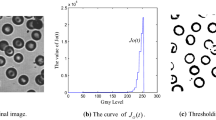Abstract
One of the important problems of automatic threshold image segmentation by brightness are questions of the number of brightness classes and, as a consequence, the required number of thresholds. The solution to the problem of estimating the number of classes in an image is often based on representing its distribution as a mixture of distributions of brightness classes. It is known that this problem (splitting a mixture) has a solution only for some types of distributions, and is difficult to apply when the distributions of brightness classes are unknown. This paper presents a nonparametric method for determining the number of classes based on rank histograms and using the property of the local spatial grouping of elements of each brightness class in the image. Comparison of the proposed method to different criteria for assessing the number of classes in images showed it to be effective.



Similar content being viewed by others
REFERENCES
P. A. Chochia, ‘‘Image segmentation based on the analysis of distances in an attribute space,’’ Optoelectron., Instrum. Data Process. 50, 613–624 (2014). https://doi.org/10.3103/S8756699014060107
M. Sezgin and B. Sankur, ‘‘Survey over image thresholding techniques and quantitative performance evaluation,’’ J. Electron. Imaging 13, 146–168 (2004). https://doi.org/10.1117/1.1631315
J. Kittler and J. Illingworth, ‘‘Minimum error thresholding,’’ Pattern Recognit. 19, 41–47 (1986). https://doi.org/10.1016/0031-3203(86)90030-0
P. A. Devijver and J. Kittler, Pattern Recognition: A Statistical Approach (Prentice Hall, Englewood Cliffs, NJ, 1982).
S. A. Aivazyan, V. M. Bukhshtaber, I. S. Enyukov, and L. D. Meshalkin, Applied Statistics: Classification and Reduction of Dimension (Finansy i Statistika, Moscow, 1989).
H. Akaike, ‘‘A new look at the statistical model identification,’’ IEEE Trans. Autom. Control 19, 716–723 (1974). https://doi.org/10.1109/TAC.1974.1100705
G. Schwarz, ‘‘Estimating the dimension of a model,’’ Ann. Stat. 6, 461–464 (1978).
S. S. Wilks, Mathematical Statistics (Wiley, New York, 1962).
P. F. Andrukovich, The Application of the Major Component Method in Practical Studies (Moscow Univ., Moscow, 1973).
J. O. Kim, Factor, Discriminant, and Cluster Analysis (Finansy i Statistika, Moscow, 1989).
A. T. James, ‘‘The distribution of the latent roots of the covariance matrix,’’ Ann. Math. Stat. 31, 151–158 (1960). https://doi.org/10.1214/aoms/1177705994
W. Widrow and S. D. Stearns, Adaptive Signal Processing (Prentice-Hall, Englewood Cliffs, NJ, 1985).
Author information
Authors and Affiliations
Corresponding authors
Additional information
Translated by L. Trubitsyna
About this article
Cite this article
Podrezov, R.V., Raifeld, M.A. Nonparametric Method of Estimating Number of Classes in Image Segmentation. Optoelectron.Instrument.Proc. 56, 280–287 (2020). https://doi.org/10.3103/S8756699020030139
Received:
Revised:
Accepted:
Published:
Issue Date:
DOI: https://doi.org/10.3103/S8756699020030139




